During the early 1960s, the Chinese merchant marine comprised only thirty vessels, but by two decades later the situation was greatly changed. Lloyd’s Register of Shipping did not publish information on Chinese shipbuilders, and only on COSCO owned Chinese shipping, until just over twenty years ago, so little was known on this subject. The meteoric rise of Chinese shipbuilding and of COSCO, founded on 27th April 1961 as the China Ocean Shipping Company, and the subsequent merger in February 2016 with container carrier China Shipping Container Lines (CSCL formed in 1997) to form the largest shipping company in the world, have now placed China in the top echelon of maritime countries. China had eleven shipping companies and five hundred ships in 1985, including fifteen feeder container ships with twenty more on order. The main shipbuilding and repair yards were at Shanghai, Dalian, Tianjin, Guangzhou and Wuhan.
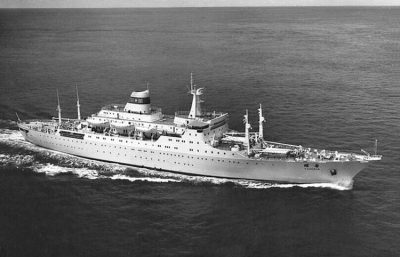
Several examples of a new type of engines aft container/passenger (CONPAX) have been completed over the last twenty years, with most for Chinese ownership. By 1998, much of the massive Chinese industrial production had relocated to the Yangtze River Delta (YRD) and the Pearl River Delta (PRD) during the two decades from 1978. There were over twenty large Chinese shipbuilding groups in operation and 45 shipyards after 1998, operating with significantly lower production costs over other countries including Japan and South Korea, as well as having a growing demand for Chinese shipping at home. China joined the World Trade Organisation (WTO) in December 2001 after fifteen years of negotiation, opening up many new markets for ships, as this lifted previous WTO restrictions on Chinese trade and industrial production. China now has 35% of global shipbuilding capacity with huge completion totals that reflect its pole position in world shipbuilding that it has enjoyed for both new ships and the order book for long series production of ships. China overtook South Korea as the leading shipbuilding nation in the world in the first half of 2010.
The Shanghai To Hong Kong Passenger Route
The former twin funnelled twin screw passenger ship Highland Princess entered service for the Chinese on the China to East Africa route in 1960 as Guanghua, and later on the route from Shanghai to Hong Kong under the modified name of Guang Hua. She had been built for Nelson Line in 1930 by Harland & Wolff Ltd. at Belfast and had transferred to Royal Mail Line two years later when taken over. After strenuous service as a troop ship, her accommodation was revamped to 100 First Class and 340 Third Class passengers. She was sold to John Latsis of Greece in 1959 and renamed Marianna, and then a year later to Czechfracht of Czechoslov-akia to become Slapy, before sailing to Shanghai by the end of 1960 as Guang Ha for service on the various routes until 1980. She had four decks with dimensions of length 544.6 feet, moulded beam of 69.2 feet and depth of 28.8 feet, fo’c’stle of length 155 feet, bridge deck of length 97 feet to give a measurement of 14,216 grt. She was designed to carry meat home from South America with an insulated space of 521,000 cubic feet and a service speed of sixteen knots from twin eight cylinder direct acting B & W oil engines. The navigating bridge was fitted with the latest radar, gyrocompass, direction finder, echo sounding and position fixing devices, and very high frequency radio telephone.
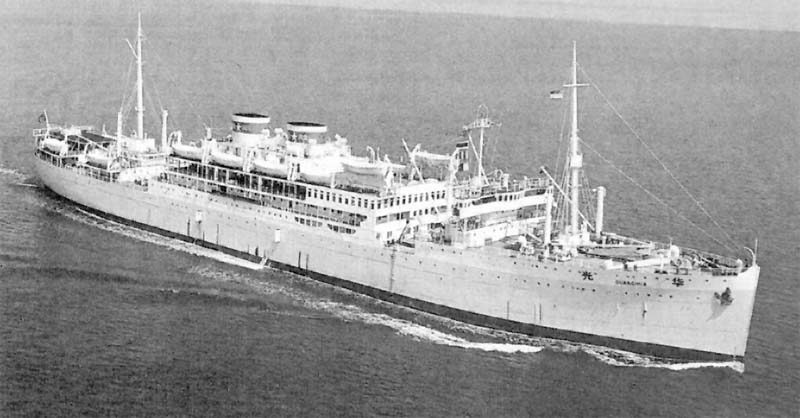
Guanghua was replaced on the China to East Africa route (Mombasa or Dar-es-Salaam) by a new French built passenger liner in 1967 named Yao Hua when launched at the St. Nazaire yard of Chantiers de l’Atlantique. She had accommodation for 488 passengers on four decks and dimensions of length 489.0 feet, moulded beam of 69.0 feet, depth of 44.0 feet and loaded draft of 21.8 feet giving a gross tonnage of 10,500. She had a single funnel placed just aft of ‘midships, a bipod navigation mast and a foremast and mainmast, with two holds forward of the superstructure and one hold aft. She was twin screw and powered by twin nine cylinder single acting Sulzer oil engines of 15,000 bhp manufactured by Compagnie Constructione Meccanica to give a service speed of 21.5 knots. Electricity was provided by four generators, and her bridge equipment had the latest and similar versions of equipment to the older Guanghua.
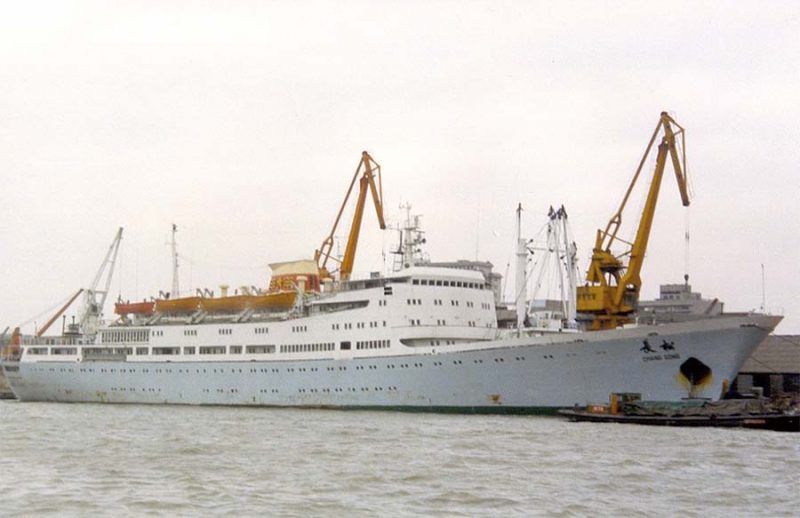
The Hudong yard at Shanghai participated along with other Chinese yards such as the Xingang Shipyard at Tianjin in the ‘Gong Nong Bing’ series of coastal passenger ships of 3,839 grt in the early 1960s on dimensions of overall length of 105.62 metres, moulded beam of 15.0 metres, and depth of 8.9 metres. They were powered by the Chinese Standard Type six cylinder four stroke diesel engine of 2,200 bhp, or in some examples by steam turbines, to give a service speed of twelve knots. They had two decks of passenger accommodation, and two holds, and two hatches worked by two derricks. They sailed from Shanghai and other Chinese ports on coastal Chinese voyages. China had a very large passenger ship fleet from the 1970s onwards due to domestic demand for coastal and Yangtze river passenger transport.
A larger series of passenger ships of 7,670 grt was begun a decade later in 1970 with the fourteen vessels of the ‘Chang’ class with accommodation for 850 passengers in two decks below the weather deck and three decks in their ‘midships accommodation. They had a raked bow, cruiser stern, with a mast above the navigating bridge and another towards the rear of the accommodation, with four derricks on a goalpost mast to serve the forward three holds carrying 3,050 tonnes of cargo. The series had dimensions of length 138.0 metres, moulded beam of 17.6 metres, and depth of 8.4 metres, and comprised the passenger liners Chang Zheng of 1971, Chang Shan of 1973, Chang He of 1974, Chang Jin of 1974, Chang Xiu of 1974, Chang Shen of 1975, Chang Zi of 1975, Chang Li of 1976, Chang Geng of 1979, Chang Liu of 1980, Chang Song of 1980, Chang Bai of 1980, Wan Nian Hong of 1984, and Zhen Zhu Mei of 1984.
The ‘Chang’ class were home ported at Shanghai, Guangzhou and Dalian, with the first unit Chang Zheng successfully put into service on the Shanghai to Dalian route. They operated as Shanghai Hai Xing Shipping Company, differing from the first nine units in some aspects of the engine room layout, with twin diesel engines of 9,000 bhp to give a total of 18,000 bhp and a service speed of 18.5 knots.
The ‘Chang’ series of passenger liners from the Hudong Shipyard gave good service of up to twenty five years, with the first nine examples broken up from 1996 onwards. The last five examples have continued in service much longer, with Chang Bai of 1980 transferred to the Shanghai Hai Xing Shipping Co. Ltd. (SHXS), set up on 1st November 1994 as one of the first experimental overseas listed companies approved by the Chinese State Council Securities Committee. Chang Liu of 1980 was renamed Lu Xing Jia during Millennium year, and then sold ten years later and renamed Oriental Queen under the Cambodian flag with her passenger accommodation extended forwards and still active today. Chang Song and Chang Bai of 1980, and Wan Nian Hong and Zhen Zhu Mei of 1984, were offered for sale in 2015, with Wan Nian Hong laid up and moored at buoys on the Huangpu river at Shanghai. The series were good looking coastal passenger liners, used by many Chinese people travelling from ports in the north, centre and south of China.
The former Blue Funnel engines aft passenger cargo-liner Centaur was acquired in the Spring of 1985 by Cosco of China, who renamed her Hai Long and registered her in Shanghai for the coastal service from Shanghai to Hong Kong. She remained in Chinese service with little alteration from her Blue Funnel service, except that her funnel was now yellow with a red band with a yellow star flanked by six wavy lines. She was renamed Hai Da in 1986 and continued on her Shanghai to Hong Kong service for another decade until the route was abandoned to airlines, and then operated across the Yellow Sea to Inchon in South Korea for another three years until laid up and eventually broken up.
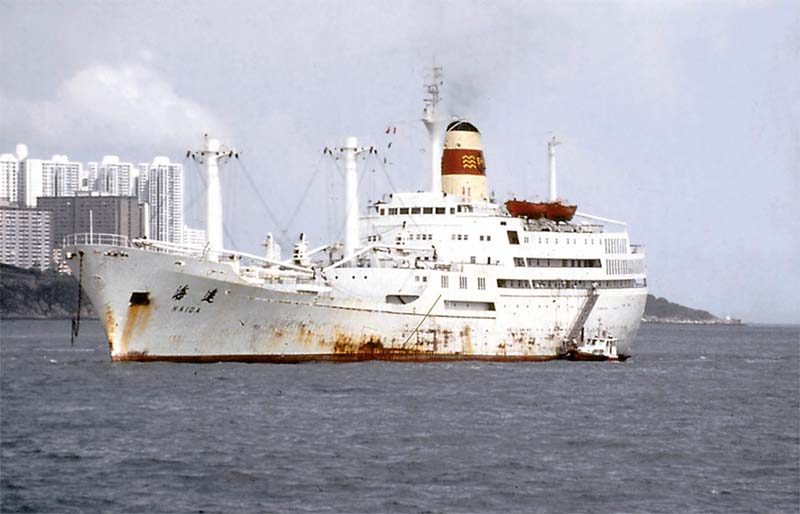
Centaur was carefully designed by Marshall Meek, the Ocean Group naval architect, before she was launched at the Clydebank yard of John Brown & Co. Ltd. on 20th June 1963 by Mrs. C. Court, wife of the Prime Minister of Western Australia. She had a novel design of a twin screw cargo, livestock and passenger ship with accommodation for 190 First Class passengers and a crew of 98 in a large all aft accommodation block of length 250 feet. Centaur had dimensions of length 480.9 feet by 66.3 feet beam with a draft of 26.4 feet and a gross tonnage of 8,262, and four holds in front of the superstructure and a fifth hold trunked down from the rear of the accommodation. She had two decks in the holds except in number five hold, with a third deck in numbers 3 and 4 holds to give a total of nine ‘tween decks. She was equipped with three cranes of three tonnes capacity and ten derricks of five tonnes capacity to handle cargo through the five hatches. She had ninety well appointed cabins for her 190 passengers, and good accommodation for her crew, and could carry 5,000 sheep and 700 cattle in hygienic conditions. She was powered by twin 11 cylinder Burmeister & Wain oil engines of 18,500 bhp supercharged with poppet valves to give a service speed of twenty knots. She was equipped with the latest bridge equipment of radar, direction finder, radio telephone, Sperry gyro compass, echo sounder and Decca Navigator. She also had capacity in the holds for 1,330 cubic metres of refrigerated cargo, with a deep tank in one of the holds for the carriage of vegetable oil, or water when in ballast. Dry cargo capacities were 8,600 cubic metres (grain) and 7,678 cubic metres (bale).
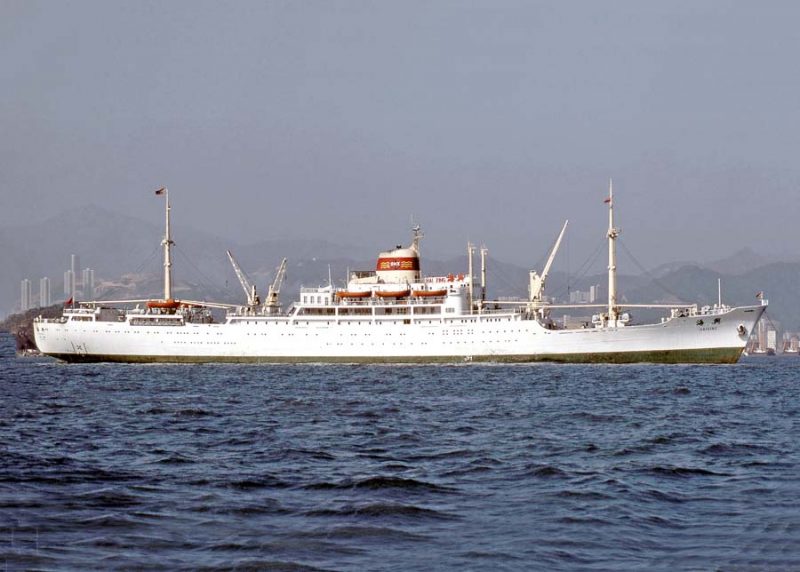
Centaur was chartered in November 1982 by Andrew Bell, Managing Director of Curnow Shipping Ltd., for a year at $10,450 per day for St. Helena service. Southbound she sailed from Avonmouth to Tenerife, St. Vincent in the Cape Verde Islands, Ascension Island, St. Helena and Cape Town, from where she sailed northbound via St. Helena. She made eight round voyages during the year long charter, and had her funnel repainted green surmounted by a large green and yellow disc badge of her charterer. She was returned to Blue Funnel, but made only one more voyage from Fremantle to Singapore with passengers, arriving there on 12th December 1983 for lay up, which lasted eighteen months.
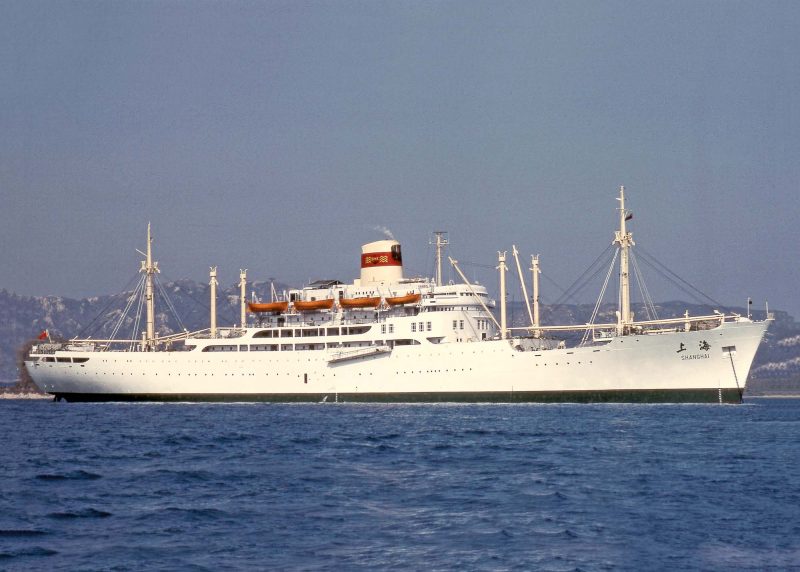
Hai Da ran alongside three other Western engines ‘midships passenger cargo-liners with large passenger capacity during her career in the former Randfontein of 13,832 grt and built in 1958, the former Baudouinville of 13,531 grt and completed in October 1957, sailing as Cathay for P. & O. from 1961 to 1975, and the former Mariposa of Matson Line completed as Pine Tree Mariner in 1952. This trio carried between two hundred and three hundred passengers whilst in Chinese service as Hai Xing, Shanghai, and Jin Jiang respectively for the Shanghai Hai Xing Shipping Company, operators of the Shanghai to Hong Kong passenger service. One other passenger cargo-liner carrying only seventy passengers was also operated by this company in the former Fabiolaville built in 1972 for CMB of Belgium, and she was sold to China in 1989 to become Hai Hua and made her last voyage from Inchon to China on 9th April 1999 and was later broken up.
Chinese Owned Engines Aft Conpax Types
The quartet of former Western passenger cargo-liners (Centaur, Randfontein, Baudouinville, and Mariposa) needed replacement in 1996 for the new service across the Yellow Sea to South Korea, and they turned to the Merwede Shipyard B.V. at Hardinxveld in Holland and the MTW Schiffswerft yard at Wismar in Germany for a new quartet. The naval architects at these two yards took instructions from the Chinese that the quartet were to be engines aft with a large accommodation block able to accommodate between 350 and 400 passengers as well as carrying 300 TEU of containers and a deadweight of 6,500 tonnes of cargo in their forward holds. The European naval architects turned to an engines aft new design, as the Chinese operators very much liked the ease of passenger and cargo carrying of Hai Da (ex Centaur), and in fact kept her in service for another three years after 1996 before she was laid up and eventually scrapped.

The Merwede shipyard at Hardinxveld received orders for yard numbers 667 and 668 and they were completed during 1995/96 as Yu Jin Xiang and Zi Ding Xiang. The latter exact sister was renamed Arafura Lily in 1996 for a brief service across the Arafura Sea, between New Guinea and Australia, from Singapore to Australian ports until she was permanently placed on Shanghai to Kobe or Inchon service. The pair had dimensions of length 148.2 metres, moulded beam of 22.7 metres and depth of 10.0 metres, with 95 passenger cabins having 348 berthed passengers in two or four berth cabins. They were powered by twin nine cylinder four stroke Sulzer diesel engines manufactured by the ‘Zgoda’ engine factory in Poland, of a combined power output of 17,640 bhp and single reduction geared to two controllable pitch propellers to give service speeds of twenty knots. They carried three generators for electrical production, and had two deck cranes of thirty tonnes capacity to handle 255 TEU of containers. They were registered under the China Shipping Container Co. Ltd. of Shanghai.
The MTW Schiffswerft yard at Wismar received orders for yard numbers 161 and 162 and they were completed during 1995/96 as Zi Yu Lan and Xiang Xue Lan. This pair had dimensions of length 150.5 metres, moulded beam of 24.0 metres and depth of 13.2 metres, and had a higher passenger complement of 392 passengers in 122 cabins than the Merwede built sisters. Gross tonnage was 16,071, larger than the 12,304 grt of the Merwede sisters, but were designed with the same type of large aft accommodation block and three forward fixed guide cellular holds and hatches to carry 293 TEU of containers. They were powered by twin six cylinder four stroke MaK diesel engines, single reduction geared, of a combined power output of 20,393 bhp to give a service speed of twenty knots from a single controllable pitch propeller. They were given three fixed guides cellular holds and three hatches, and were designed as long distance liners, but apart from brief service to Australia from Shanghai and from Hong Kong to the Philippines, they have spent their careers on short routes from Dalian, Yantai or Shanghai to Inchon. They have a yellow funnel with a black top and a central red and blue logo, with six red lifeboats stowed in recessed easy release positions in the superstructure. They were originally owned by the China National Machinery Import and Export Corporation, with both later transferring to the Yantai Ferry Company for sailings from Yantai to South Korea.
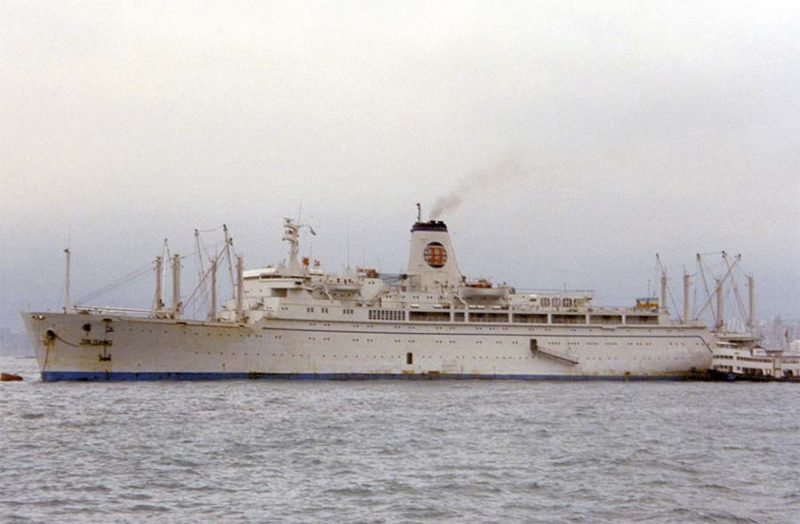
Dalian was formerly known as Dairen, and also briefly as Port Arthur during a British occupation between 1858 and 1860 of the Liaoning Peninsula with the port at its southern tip. Dalian harbour is on Bohai Bay and is one of the five largest ports in China. Dalian with the other major ports of the Bohai Bay Sea Rim of Tianjin, Qinhuangdao, Tangshan and Huanghua have now accelerated the pace of their integrated joint development. Dalian is the home port of the Dalian Steam Shipping Company operating two Chinese built ferries across the Yellow Sea. The sister passenger cargo-liners Tian Chi and Tian Hu of 5,002 grt were built in 1981 by the Xingang Shipyard at Tianjin with twin holds and hatches served by four derricks, with a service speed of fifteen knots from twin twelve cylinder four stroke diesel engines of 4,500 bhp and built by the Shanghai Diesel Engine Co. Ltd.
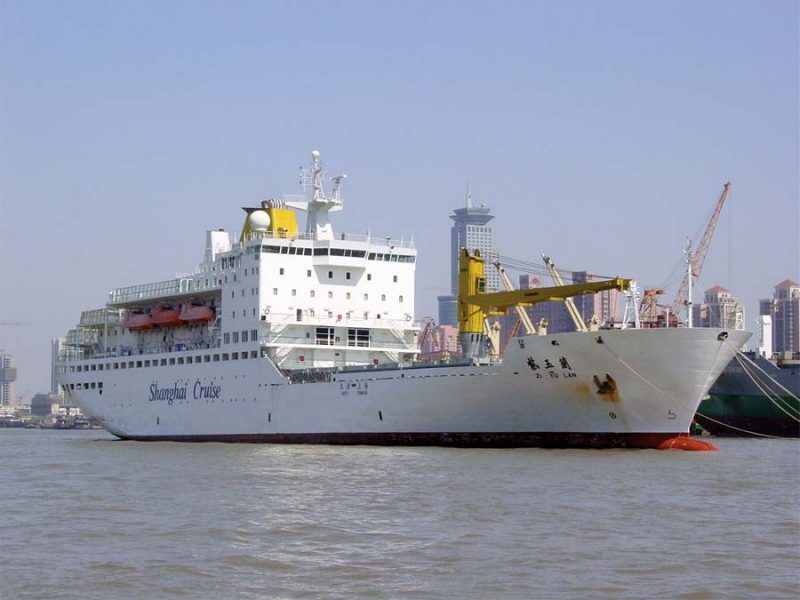

The expansion of the Chinese shipbuilding industry has taken place in a short space of time, as only 18% of the Chinese merchant fleet was domestically produced in 1986, and the vast majority of Chinese trade was carried in chartered or foreign flag shipping. Chinese shipyards built one million gross tonnes of ships in 1993, with roughly half for export, giving it a third position in world shipbuilding output after Japan and South Korea. There are 45 shipbuilding yards in China in production today, with fourteen in the Shanghai area, eight more on the Yangtze river, and nine in the Shandong and Dalian areas of Northern China. The Pudong New Area on the east side of the Huangu river at Shanghai, where some of the big yards are located, was only developed from 1990 onwards. Shanghai became the largest Chinese shipbuilding hub in 2015 with an increase of annual production capacity to 12 million dwt. The Chinese Government has limited foreign shareholdings in Chinese shipbuilding groups and yards to only 49% in order to retain the world dominance of their huge shipbuilding industry.
Chinese yards took orders for series production of many types of ships in 2007 of 29.6 million gross tonnes, as opposed to 32.0 million gross tonnes of orders taken by South Korean yards. China thus moved into second position in world shipbuilding, and then moved into pole position in the world by overtaking South Korea in the first half of 2010. Today, China has thirty VLCC tanker capable building docks and 35% of global shipbuilding capacity. Thus, China has become the largest producer of merchant ships in the world in only thirty years or so after their ability to build long series of general cargo ships and other types of ship was only beginning to be realised in Western countries.
Engines Aft Conpax Designs Of Other Countries
The classic engines aft container passenger (CONPAX) vessel Americana was completed in February 1988 to the same general design as Centaur. She had berths for 88 (later 110) passengers in 52 cabins and was able to carry 1,120 TEU of containers when completed by the Hyundai Heavy Industries yard in Ulsan in South Korea with dimensions of overall length 176.71 metres, moulded beam of 26.01 metres, and depth of 13.21 metres with a draft of 9.52 metres. She had four cellular container holds and one combination hold in front of the engine room, and three tanks aft, with a total of fifteen hatches and also twin cranes of 45 tonnes capacity to handle her containers. She had a service speed of 18.3 knots from a seven cylinder two stroke B & W oil engine of 14,726 bhp for her Ivaran Lines trade between New York and several Brazilian ports plus Montevideo and Buenos Aires. However, her container capacity was too small for this important trade, and Ivaran Lines was purchased by CP Ships, and Americana made her last southbound circuit from New Orleans on 21st May 1999 with passengers. She was then employed in the container only mode until sold in 2004 to Sinokor Merchant Marine Co. Ltd. of South Korea, who renamed her Golden Trade. She arrived at Shanghai in January 2010 for breaking up under this name.

R.M.S. St. Helena was completed in 1990 at Aberdeen by A & P Appledore to this same basic design, although her engine room is only ‘two-thirds’ aft, and was reviewed by myself as a ‘Memorable Ship’ in the July 2016 issue of this magazine. Suffice to say, her almost engines aft design for 132 passengers on four decks, and ability to carry 1,800 tonnes of cargo and 56 containers on her specialist route to serve the island of St. Helena in the South Atlantic, and also Ascension Island, has been a great success. She is still in use in 2018 after 28 years of service, although is about to be replaced in her important role, even after the very expensive new airport on St. Helena was completed in 2016, but was deemed unusable except for medical emergencies due to severe cross winds encountered near the eastern part of St. Helena, where the airport was constructed.
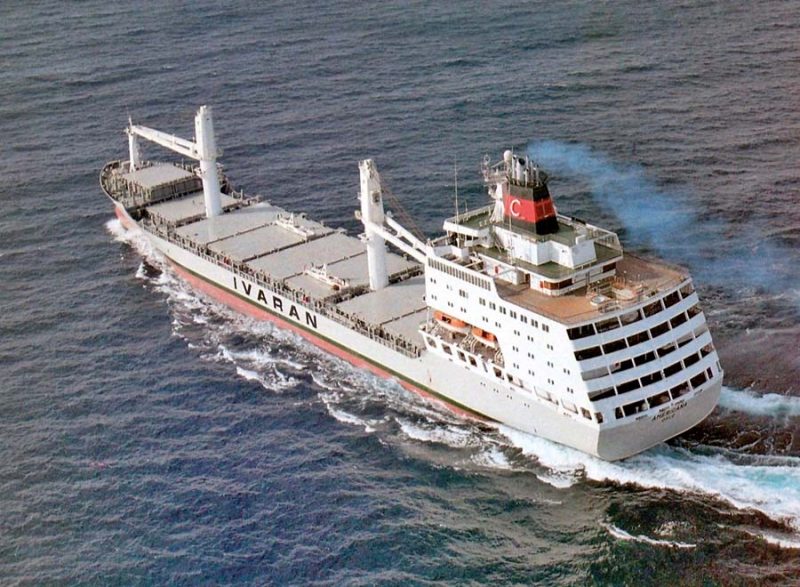
Four further Chinese or Roumanian built engines aft container/passenger have been completed to the basic engines aft design. The first was completed five years after the European built quartet in 2001 by the Hudong Shipyard in Shanghai as Mauritius Trochetia for a designed service between Port Louis on Mauritius and Port Mathurin on Rodrigues Island, a dependency of Mauritius with a population of six thousand. She is owned by the Mauritius Shipping Corporation Ltd., and managed by the Societe de Gerance Maritime S.A. of Port Louis. The hull was built of part high tensile steel on a length of 107.0 metres, moulded beam of 17.65 metres, and depth of 8.4 metres, and loaded draft of 5.5 metres.
Mauritius Trochetia was given a blue hull with red boot topping, and a four deck white accommodation block aft with accommodation for 112 passengers in 52 cabins. She has three cellular holds and three hatches forward to carry 3,500 tonnes of cargo and 165 containers, which are lifted on and off by twin cranes of thirty tonnes capacity located on pedestals on the extreme port side. She is powered by twin six cylinder four stroke Wartsila diesel engines of 6,118 bhp power output connected by clutches, flexible couplings and reduction gearing to a single propeller to give a service speed of fourteen knots. A single white funnel is placed at the end of the navigation bridge deck and has the colourful red, green and yellow bands of the Mauritius flag beneath a black top. She also calls at Agalega, a group of two small islands 620 miles north of Port Louis, together with the company consort vessel, Mauritius Pride.
Aranui 3 was a passenger and cargo vessel of 7,325 grt and 3,200 dwt with two cranes to serve her three holds, and a large superstructure aft of eight decks for 208 cabin class passengers. She was completed at the Severnav yard at Severin in Roumania on 24th December 2002 and made the long voyage to the South Pacific to sail on her maiden voyage on 1st March 2003 from Papeete to the Marquesas Islands in the South Pacific, her designed trade. She had dimensions of length 383.9 feet, moulded beam of 57.9 feet and draft of 18.1 feet, and a service speed of fifteen knots from a MaK diesel of 5,150 bhp. She made fourteen day voyages to the Marquesas returning via Rangiroa and Fakarava in the Tuamotu Islands until her last voyage ended at Papeete on 4th December 2015, and she was replaced by Aranui 5.
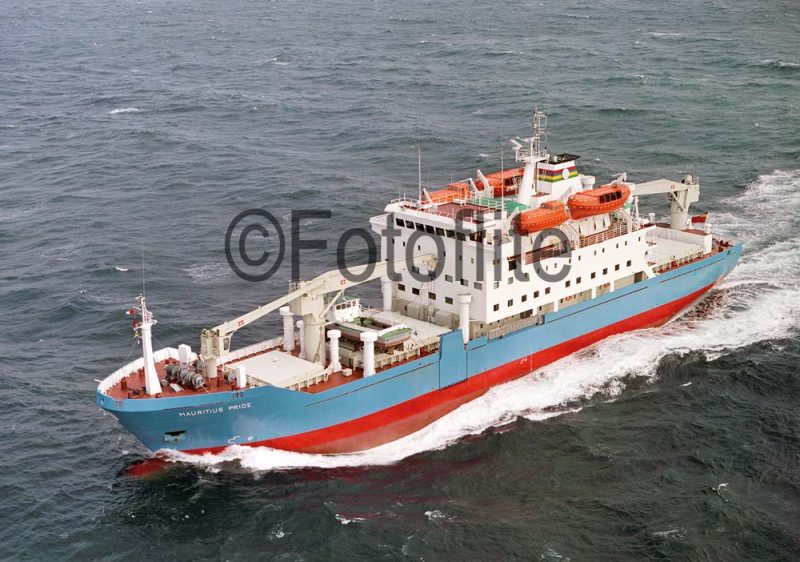
Aranui 5 is a passenger and cargo vessel of 7,500 grt and 3,300 dwt built for service in the Marqueseas Islands with two cranes to serve her three holds, and a large sweeping superstructure aft of ten decks for 256 cabin class passengers and replaced the earlier Aranui 3 of 2003. The aft part of the superstructure is open over three decks, sweeping down between the curved edges of the sides. She was constructed by the Huanghai Shipbuilding yard at Shandong in China in 2015 and arrived at Papeete for the first time on 9th November 2015. She is registered in her home port of Papeete, and transports cargo in three holds served by two cranes and passengers to the six ports of Nuku Hiva, Ua Huka, Ua Pou, Hiva Oa, Tahuata and Fatu Hiva in the Marquesas, with return calls at the islands of Rangiroa and Takapoto in the Tuamotu Group before returning via Bora Bora in the Society Islands to Papeete.
Aranui 5 has dimensions of length 413.5 feet, moulded beam of 78.9 feet, and draft of 18.1 feet, and a crew of 64 of whom some play in the Aranui Band with Polynesian rhythms to help digest your three course dinners. She has been in service since her maiden voyage of 12th December 2015 to give passengers a cultural experience they will never forget. The owners, C.P.T.M. of Papeete, have a Head Office in Papeete, an American office in San Mateo (California), an Australian office in Taylors Lakes (Victoria), and a European office in Paris. Mauritius Trochetia, Aranui 3 and Aranui 5 are smaller examples of the same design of the four larger Chinese passenger cargo-liners operated across the Yellow Sea that dated from 1995/96.
Ocean Blue Whale
An interesting completion in 2017 was a new engines aft container/passenger (CONPAX) vessel named Ocean Blue Whale of 19,480 grt. She has accommodation for 750 passengers and a container capacity of 460 TEU when sailing fully loaded at the high speed of 23 knots on the short route between Yantai, on the eastern tip of Shandong province in China, and Pyeongtaek, to the south of Inchon and Seoul, in South Korea. She is the latest example of this new ship type and is owned by Bohai International Ferry HK, a Chinese partner of Yantai Ferry, a joint venture corporation, and operated on a long bareboat charter to Yantai Ferry. The order was placed in September 2015 with the Huanghai Shipbuilding Corporation based at Shidao, and she was launched on 6th December 2016, completed on 8th June 2017, and entered service on 4th July 2017 to South Korea.
Ocean Blue Whale has dimensions of length 182.6 metres, moulded beam of 12.1 metres, and is powered by twin M.A.N. diesel engines of very high power output to produce her high service speed, and they were built by Dusan Heavy Industries. She has two controllable pitch propellers, two flap type rudders, as well as fin stabilisers and anti-heeling tanks. A crew of fifty is on hand to help passengers enjoy her wide range of amenities in her public rooms, including dining rooms, buffet restaurants and banqueting halls, bars, karaoke room, recreation room, casino and gaming room, cinema, chess and card room, and outdoor barbecue areas. The aft accommodation block of Ocean Blue Whale occupies between half and almost two thirds of her total length, with the forward five hatch covers having provision for deck stacked containers, and in the fixed guide cellular holds below. Ocean Blue Whale has a blue hull with ‘YANTAI FERRY’ in large white letters and a blue hull stripe, and a large blue whale on her white superstructure and on her funnel and superimposed on colourful bands of yellow, red, green and blue. An open air top deck and several shaded lido decks are provided at her stern for the enjoyment of her passengers.
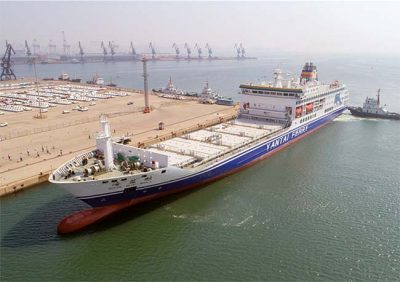
The Yantai Sino-Korea Ferry Company Ltd. is a joint venture between three Chinese shipping companies (Qingdao Ocean Shipping Company, Shandong Yantai Ocean Shipping Company, Yantai Foreign Shipping Agency Company) and a South Korean ferry company. It was established around the same time as the Bohai Train Ferry Company in December 2003 and approved at National Chinese level. The latter runs three train ferries across this short stretch of sea, with an undersea tunnel also approved and awaiting funding and design work.
Ocean Blue Whale of 19,480 grt is the largest and best example of this design of modern container passenger ship (CONPAX) from the Huanghai yard. This yard has also recently built three very large conventional design passenger ferries of 35,092 grt in 2016/17 in Huadong Pearl VIII, Oriental Pearl VIII and New Shidao Pearl for the Huadong Ferry Company operating across the Yellow Sea to South Korean ports. New Shidao Pearl was launched on 2nd July 2017 by the Huanghai yard, and this trio have dimensions of overall length 196.0 metres, moulded beam of 28.6 metres, depth of 22.0 metres and are designed to carry 1,200 passengers, with a lane length of 1,680 metres for cars, trailers and lorries on their car decks. Ocean Blue Whale operates with this trio across the Yellow Sea to Pyeongtaek in South Korea. A fifth vessel was laid down by the Huanghai yard on 8th September 2016 to join this quartet on the Yellow Sea route to South Korea. Many passenger ships sailing on this route from China to South Korea are at least twenty years old with problems of fuel emissions, environmental waste, noise and safety issues, and this new quintet will bring this popular route up to date and with many new facilities for their passengers. There are a dozen sea routes from Chinese ports to South Korea running two or three times per week, with the voyage time between sixteen and twenty four hours. A similar number of crossings are available from Chinese ports to Japanese ports.
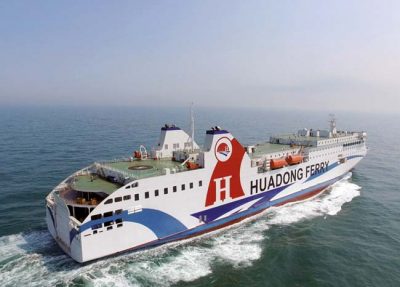
Future Engines Aft Conpax Ships
The thirty examples of passenger or CONPAX container/passenger vessels reviewed here in this article will be followed by many more examples in due course from the huge shipbuilding production capacity of China. The Hudong shipyard will build more examples as it merged during Millennium year with the nearby Zhonghua shipyard to form the very large shipbuilding enterprise Hudong-Zhonghua Shipbuilding (Group) Co. Ltd. under the leadership of the China Shipbuilding Group Corporation (CSSC). The Zhonghua yard in Shanghai also built coastal passenger ships in the 1960s and 1970s, and completed the blue hulled ro-ro Catherine of 21,287 grt in 2002 for the Cobelfret service from Purfleet on the Thames to Rotterdam and other Continental ports. Catherine has a lane length of 2,750 metres for 600 cars, 212 trailers and 504 TEU of containers, and carries newsprint, paper and forestry products with a service speed of 18 knots powered by a twelve cylinder four stroke Wartsila 12V46C diesel engine.
In the seven years to the end of 2007, the merged Hudong-Zhonghua yards built 114 ships of six million tonnes deadweight, and had an order book for 62 ships of 4.2 million tonnes deadweight. The merged yards now build ships up to 120,000 dwt, and repair ships up to 500,000 dwt, as well as building large slow and medium speed marine diesel engines, and many types of large steel structures e.g. bridges, towers and gas tanks. Their annual steel production is 80,000 tonnes, and Head Office of the Group is located at Pudong New Area, with major production areas in the eastern part of Shanghai along both sides of the Huangpu river, and a big workforce of 11,000.
The Hudong-Zhonghua yards build many types of ship including engines aft container passenger (CONPAX) ships outlined in this article, large crude oil tankers and bulkers and container ships, product tankers, reefers, 30,000 dwt coal carriers of shallow draft, offshore floating production and storage (FPSO) vessels, LPG and LNG gas carriers, anchor handling tug supply ships, and many other types of vessel. The building berths number five for ships up to 120,000 dwt, and the three graving docks accommodate ships up to VLCC and ULCC size, and 120,000 dwt, and 80,000 dwt, and there are several outfitting quays, and all are equipped with 600 tonne and 100 tonne capacity cranes, while there are other facilities for repairs afloat. A long history of eighty years since 1928 has seen over three thousand ships of very many different types completed by the Hudong yards. Production of engines aft passenger ships, ro-ro paxes, passenger and general cargo ships, and train ferries have increased in number amongst the increasingly complex ships the merged yards can now build.
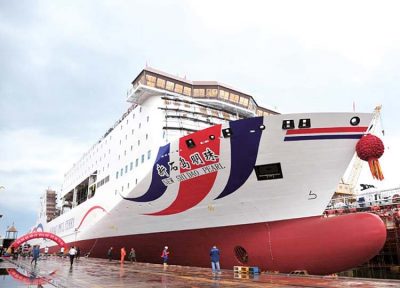
The Huanghai Shipbuilding Corporation was founded in 1944 as the Shandong Huanghai Shipbuilding Corporation, and changed its name in 2007 to the Huanghai Shipbuilding Corporation and is located on the southern side of the Shandong peninsula in Northern China. It has built many general cargo ships, bulkers, container ships and multi-purpose heavy lift ships, as well as the ‘Zhu Series’ of large ro-ros of 1,600 passenger capacity and 2,000 metre lane length for the Bohai Ferry Company. It is currently completing four more large ro-ros for Bohai Ferry of 2,296 passenger capacity and 2,500 metre lane length. This quartet will be equipped with M.A.N. four stroke diesels of 16,000 bhp operating at 750 rpm and built at Augsburg in Germany to give service speeds in excess of twenty knots. The yard has built the CONPAX vessels Ocean Blue Whale and Aranui 5 during the last three years, and will be certain to build more of this new evolving Chinese ship design in the future.
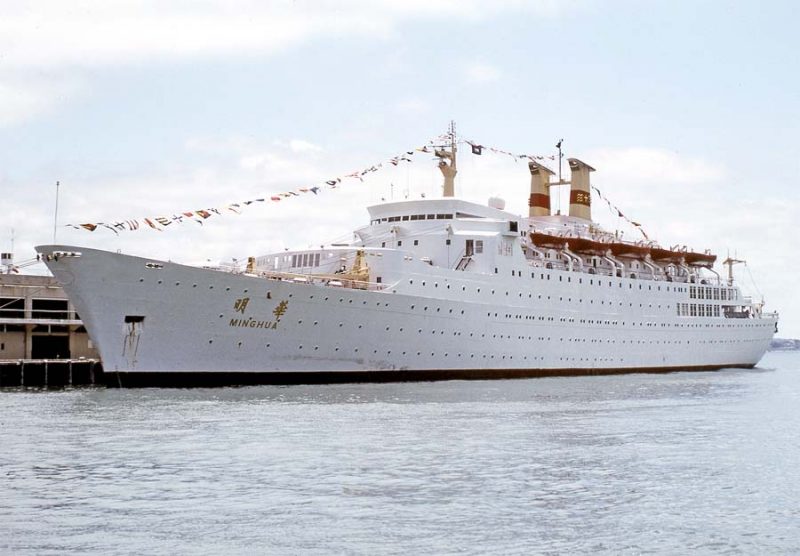
Postscript
The China State Shipbuilding Corporation (CSSC) will build the first ever large luxury cruise ship to be built in China when it is completed in 2021. The mega cruise ship will accommodate 4,980 passengers and will be a version of the successful series of cruise ships built by Fincantieri of Italy for Carnival Cruises of Miami. CSSC will work with both of these companies to build this and similar cruise ships of the future, as the Chinese cruise market is expected to triple in size from two million passengers in 2016 to six million passengers by 2020. Shanghai and Dalian have been named as two of the six key cities chosen to participate in the Cruise Tourism Development Area to boost this rapidly expanding Chinese cruise market. Costa Cruises came to China in 2006, and Princess Cruises have Majestic Princess cruising from Shanghai in 2017. The Chinese cruise market is growing at a rate of 40% year on year. Thus, the dominant Chinese shipbuilding industry will gain experience in the fitting out of a large and complex cruise ship, and in future will increase the sizes and types of ships that it is very capable of building. The Chinese are a very intelligent race of people, and will not relinquish their lead in world shipbuilding, as they have plenty of spare capacity to counter any threat from South Korea or any other shipbuilding country.

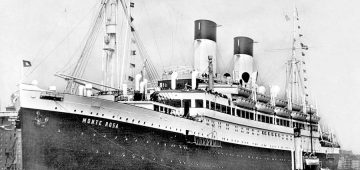
Comments
Sorry, comments are closed for this item